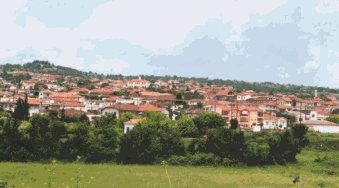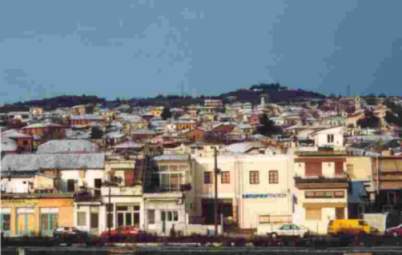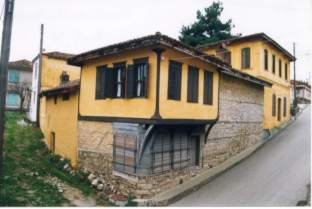Soufli was built on the eastern slope of the twin hill of Prophet Elias, one of the last peaks on the Rodopi mountain.
 It is situated in the center of the prefecture of Evros and is 65km away from Alexandroupoli (south) and 50km away from Orestiada (north).
It is situated in the center of the prefecture of Evros and is 65km away from Alexandroupoli (south) and 50km away from Orestiada (north).
It is considered to be part of the valley of Evros, being only 500m away from the Evros river.
It is the unique town of silk, also famous for its wine, its tsipouro(a local strong alcoholic drink) and its cooked meats, as well as for its long tradition and cultural heritage.
Soufli is first mentioned in writing by Turkish sightseer Evligia Tselebi, around 1667, by the name Sofulu. During that period, it was a large village, free from taxation. Its Turkish name, Sofulu probably came from an old Muslim monastery of the region. But there is another version, attributing the origins of the name to a Byzantine landowner called Souflis.
However, it is historically confirmed that Soufli was inhabited even during Alexandrian times. Evidence is provided by several objects found in the territory, as well as certain tombs discovered there, dating from the Hellenistic period. Beginning from the 19th century, Soufli has been the administrative center of a rich province, with almost 60.000 inhabitants, extending on both sides of the valley of the river Evros.
Due to the significant gathering of population as well as to lack of nearby towns, Soufli was distinguished as an important trading center of the wider region.
From the Consulate of Greece in Adrianoupolis, we learn that in 1858 there was a mutual teaching school in Soufli, and the community put up 6.500 piastres to pay for teachers.
Between 1870 and 1880, Soufli developed significantly. The construction of the railway and of the railway station (1872) gave a boost to its economic development.
At the same time, the discovery of a method to fight against the diseases of cocoons by Paster contributes to the fast development of sericulture.
In 1877, the number of the inhabitants of Soufli is estimated to be around 4.680.
In 1900 the population rises to 10.000 inhabitants, and in 1908 to 12-13.000 inhabitants.
Together with its importance as a trading center, Soufli was also recognized as an important craft center. We must especially mention the work of the cartwrights, who provided the whole region of Thrace with ox-carts, famous for their exceptional stability.
The second most important industry in Soufli, next to sericulture, but even older, is viniculture.
As an indication of this fact, we should mention that wine production in Soufli during the 19th century was just under 2.000.000ltr.
However, the development of sericulture and the diffusion of the cultivation of mulberry trees that followed, resulted in the reduction of viniculture. But sericulture, although popular, was not the only occupation. It was considered to be more of a side-line and seasonal occupation. It had entered every house in Soufli, and during the two months of May and June it occupied farmers, merchants and craftsmen and provided a very satisfactory income.
Cultural flourishing
Together with economic development there came socio-cultural flourishing and the intellectual level of the inhabitants was raised. Before the middle of the 19th century, the two churches of Saint George and Saint Athanassios were already built and are still standing as real jewels of the town.
Around 1860, we have the creation of the Civil School (today it is the town's Second Elementary School), and in 1880-82 the Girls School of Soufli is built and comes into operation (today's First Elementary School).
In 1878, the Dramatic society of Soufli was already in existence, and in 1905-10 another Dramatic society comes forward. Music has been taught in the Civil School since 1900.
Balkan wars World War I
However, first the Balkan wars, and, subsequently World War I after that transformed the region of Thrace into a seat of war operations, resulting in the crisis of sericulture and the general downgrading of the region until 1920.
 In addition, the incorporation of Soufli in Greece after 1922 has indicated its economic decline. The loss of the inland on the eastern riverside of Evros and the subsequent decrease in population of what was now the Greek province of Soufli resulted in the dwindling of the local market and, consequently, the restriction of the trading and craft activities of the town. That is how Soufli, from the transit and trading center it used to be, was transformed into borderland, with all the subsequent disadvantages. Moreover, the partition of Thrace deprived Soufli from a large part of its estates in the eastern riverside of Evros, which now passed into Turkish possession. In particular, in 1922, 2.250 acres of mulberry trees and 625 acres of fields remained in the possession of Soufli, while the vineyards were completely destroyed by vine louse.
In addition, the incorporation of Soufli in Greece after 1922 has indicated its economic decline. The loss of the inland on the eastern riverside of Evros and the subsequent decrease in population of what was now the Greek province of Soufli resulted in the dwindling of the local market and, consequently, the restriction of the trading and craft activities of the town. That is how Soufli, from the transit and trading center it used to be, was transformed into borderland, with all the subsequent disadvantages. Moreover, the partition of Thrace deprived Soufli from a large part of its estates in the eastern riverside of Evros, which now passed into Turkish possession. In particular, in 1922, 2.250 acres of mulberry trees and 625 acres of fields remained in the possession of Soufli, while the vineyards were completely destroyed by vine louse.
During the new period beginning with the incorporation of Soufli in Greece, sericulture remained as the most important source of income for the inhabitants of Soufli.
The cultivation of wheat, corn and rye provided the town with self-sufficiency as far as nutrition was concerned, and the inhabitants made use of the empty space among mulberry trees and planted mainly legumes and other early or late cereals (multi-culture).
World War II
With World War II and the German occupation, every trading or intellectual activity is stopped. Life is only vestigial. With the withdrawal of the Germans in August 1944 and the beginning of the civil war, Soufli is once more full of life. The inhabitants of the nearby villages gather in Soufli for safety, and they stay there until the end of 1948.
More recent years
Since 1949, the inhabitants of Soufli, peace-loving, forward-looking and hardworking, have never ceased to fight in order to ameliorate their living conditions.
However, the invention of synthetic silk and the fall of the prices of cocoons have led to the decline of sericulture. Mulberry trees are becoming fewer and fewer, and after the re-allotment of land they have almost vanished.
The decline of sericulture, in combination with the lack of industrial units, has forced the population to move towards urban areas or even abroad.
Taken from www.phantis.com

